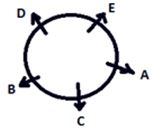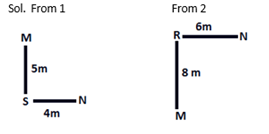Dear Friends, SBI Clerk 2018 Notification has been released we hope you all have started your preparation. Here we have started New Series of Practice Materials specially for SBI Clerk 2018. Aspirants those who are preparing for the exams can use this “20-20” Reasoning Questions.
[WpProQuiz 1361]Click “Start Quiz” to attend these Questions and view Explanation
Daily Practice Test Schedule | Good Luck
| Topic | Daily Publishing Time |
| Daily News Papers & Editorials | 8.00 AM |
| Current Affairs Quiz | 9.00 AM |
| Logical Reasoning | 10.00 AM |
| Quantitative Aptitude “20-20” | 11.00 AM |
| Vocabulary (Based on The Hindu) | 12.00 PM |
| Static GK Quiz | 1.00 PM |
| English Language “20-20” | 2.00 PM |
| Banking Awareness Quiz | 3.00 PM |
| Reasoning Puzzles & Seating | 4.00 PM |
| Daily Current Affairs Updates | 5.00 PM |
| Data Interpretation / Application Sums (Topic Wise) | 6.00 PM |
| Reasoning Ability “20-20” | 7.00 PM |
| English Language (New Pattern Questions) | 8.00 PM |
| General / Financial Awareness Quiz | 9.00 PM |

Click Here for SBI Clerk Prelims and Mains 2018 – Full Length Mock Test
Directions (Q. 1-5): In each of the questions below are given four statements followed by four conclusions numbered I, II, III & IV. You have to take the given statements to be true even if they seem to be at variance with commonly known facts. Read all the conclusions and then decide which of the given conclusions logically follows from the given statements disregarding commonly known facts.
1) Statements:
All stores are baskets. Some baskets are sticks. All sticks are chains.
Conclusions:
I.Some chains are stores.
II.Some sticks are stores. .
III.Some chains are baskets.
- None follows
- Only I follows
- Only II follows
- Only III follows
- Only II and III follow
- Statements:
Some desks are chairs. All chairs are ropes. Some ropes are walls.
Conclusions:
I.Some ropes are desks.
II.Some walls are chairs.
III.Some ropes are chairs.
- Only I and II follow
- Only I and III follow
- Only II and III follow
- All I, II and III follow
- None of these
- Statements:
All rooms are wires. All wires are roads. All roads are cars.
Conclusions:
- Some cars are rooms.
- Some roads are rooms.
- Some cars are wires.
- Only I and II follow
- Only II and III follow
- Only I and III follow
- All I, II and III follow
- None of these
- Statements:
All tables are pencils. No pencil is box. Some boxes are mats.
Conclusions:
- Some mats are pencils.
- Some boxes are tables.
- Some mats are tables.
- None follows
- Only I follows
- Only II follows
- Only III follows
- Only I and II follow
- Statements:
Some chairs are handles. All handles are pots. All pots are mats. Some mats are buses.
Conclusions:
I.Some buses are handles.
II.Some mats are chairs.
III.No bus is a handle.
IV.Some mats are handles.
- Only I, II and IV follow
- Only II, III and IV follow
- Only either I or III and II follow
- Only either I or III and IV follow
- Only either I or III, II and IV follow
Directions (6-10): Study the following information carefully and answer the given questions.
Ten persons from different countries viz. Germany, Russia, Japan, Malaysia, China, France, Singapore, Australia, Spain and Thailand are sitting in two parallel rows containing five people each, in such a way that there is an equal distance between adjacent persons. In row-1 Naveen, Ganesh, Janani, Vivek and Ramesh are seated and all of them are facing south. In row-2 Karthik, Balaji, Varun, Santhosh and Thiru are seated and all of them are facing north. Therefore in the given seating arrangement, each member seated in a row faces another member of the other row. (All the information given above does not necessarily represent the order of seating in the final arrangement.) Karthik faces one of the immediate neighbours of the person from Russia. Karthik does not face Naveen. The person from Germany sits immediate right of the person from Australia. Vivek faces one of the immediate neighbours of the person from Japan. Santhosh is not from Japan. Vivek is neither from Francenot from China. Varun sits second to the left of the persons from Thailand. Naveen sits third to the right of person from France. Only one person sits between the person from Spain and Balaji. The person from Malaysia sits to the immediate right of Balaji. Janani sits to the immediate left of the person who faces Balaji. Only two people sit between Ganesh and Ramesh. The person from China sits second to the right of the one who faces Santhosh. Santhosh does not sit at an extreme end of the line. One of the immediate neighbours of the person from China faces Spain.
- Varun belongs to ____________
- France
- Australia
- Malaysia
- Germany
- Singapore
7). Who sits second to the left of the person the one who belongs to Japan?
- Thiru
- The one who belongs to China
- The one who belongs to Malaysia
- Varun
- None of these
8) Who belongs to Spain?
- Santhosh
- Naveen
- Thiru
- Janani
- Vivek
9) The one who belongs to Thailand sits opposite to the _____________
- The one who belongs to Australia
- The one who belongs to Germany
- Vivek
- Both option a and c
- None of these
10) Which of the following persons sits at the extreme ends of one row?
Naveen and Ganesh
Varun and Karthik
Vivek and Janani
Balaji and Santhosh
Ramesh and Naveen
Direction (11-15): Each of the questions below consists of a question and two statements numbered I and II given below it. You have to decide whether the data provided in the statements are sufficient to answer the question. Read both the statements and give answer
(a) if the data in statement I alone are sufficient to answer the question, while the data in statement II alone are not sufficient to answer the question.
(b) if the data in statement II alone are sufficient to answer the question, while the data in statement I alone are not sufficient to answer the question.
(c) if the data either in statement I alone or in statement II alone are sufficient to answer the question.
(d) if the data in both statements I and II together are not sufficient to answer the question.
(e) if the data in both statements I and II together are necessary to answer the question.
11). There are five persons A, B, C, D and E sitting in a circle facing towards outside. Who is on the immediate right of D?
- B sits 2nd to the right of A. C sits third to the right of D
- C sits between B and A.
12). What is the shortest distance between two points `M’ and `N’?
- ‘M’ is 5 m North from point ‘ S’, which is to the west of ‘N’ at a distance of 4 m.
- A point ‘R’ is in the West of ‘N’ at a distance of 6 m and to the North of ‘M’ at a distance of 8 m.
13). Who is R’s Brother?
- M is son-in-law of A, who is married to B. B is the mother of R
- M is the father of A. S is mother R, and is married to M.
14). Who among the five friends A, B, C, D and E is the oldest?
- E is older than three of them but A is younger than C.
- B is older than D and E.
15). Who among the following is the shortest in height?
There are five student A, B, C, D and E in a class. A is taller than both B and D but not the tallest.
C is taller than A. E shorter than B and D
Directions [Q. 16-20]: Study the following information carefully and answer the given questions.
Seven Banking Aspirants Aathi, Bahu, Ciny, Deny, Elina, Faritha and Gaya wrote the SBI PO and the IBPS PO Examination. They scored 10, 20, 30, 40, 50, 60 or 70 for every exam not necessarily in the same order.
- Only Elina had scored same in both the exams.
- In the SBI PO Exam Deny scored 40 more than Ciny.
- Only Bahu’s and Ciny’s total score of both the exams is same.
- Deny scored twice of Gaya in total (sum of both the exams).
- Bahu’s score in SBI PO exam was equal to Faritha’s score in the IBPS PO Exam.
- Faritha’s total score of both the exams was 110. A score less marks in SBI exam than G in same exam.
- Not more than 2 persons scored less than Elina in the IBPS PO exam.
- Ciny’s score in IBPS PO Exam was twice his score in SBI PO Exam.
16). Who among the following scored the highest in the SBI PO Exam?
- A
- B
- D
- G
- F
17). If the cut off for both the exams was kept as 47.5 then who among the following will qualify both the exams.
- A
- B
- C
- D
- F
18). Who among the following has the 2nd highest total?
- A
- B
- C
- D
- Both B and C
19). What is the difference between A’s SBI PO Exam’s score and G’s IBPS PO Exam’s score?
- 0
- 10
- 20
- 30
- 40
20). Who among the following scored the least in IBPS PO Exam?
B
D
E
F
G
Explanation:
1). Answer: d
2). Answer: b
3). Answer: d
4). Answer: a
5). Correct Answer: e
Direction (Q 6-10)
| Facing South | Ganesh/Ramesh
(China) |
Naveen
(Germany) |
Vivek
(Australia) |
Ramesh/Ganesh
(Russia) |
Janani
(France) |
| Facing North | Varun
(Singapore) |
Thiru
(Spain) |
Santhosh
(Thailand) |
Balaji
(Japan) |
Karthik
(Malaysia) |
6). Correct Answer is: e)
7). Correct Answer is: a)
8). Correct Answer is: c)
9). Correct Answer is: d)
10). Correct Answer is: b)
11). Correct Answer is: e)

12). Correct Answer is: c)

13). Correct Answer is: d)
The data in both statements I and II together are not sufficient to answer the question.
14). Correct Answer is: e)
It is clear from both statements that B is the oldest.
15). Correct Answer is: e)
C > A > B/D > B/D > E
Directions(Q.16-20):
| Name | SBI PO | IBPS PO | TOTAL |
| Aathi | 10 | 70 | 80 |
| Bahu | 50 | 40 | 90 |
| Ciny | 30 | 60 | 90 |
| Deny | 70 | 30 | 100 |
| Elina | 20 | 20 | 40 |
| Faritha | 60 | 50 | 110 |
| Gayu | 40 | 10 | 50 |
16). Correct Answer is: c
17). Correct Answer is: e
18). Correct Answer is: d
19). Correct Answer is: a
20). Correct Answer is: e
Click Here for SBI Clerk Prelims and Mains 2018 – Full Length Mock Test





